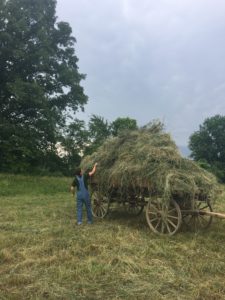By Gabe Ross, Gallant Farm Manager

Every year, we put up hay at Gallant Farm, but this year there are some updates to the system. Instead of putting it on the ground in the barn as in the past few years, we are now able to put it up in a new loft that was constructed last fall with funding left to the park system by Linda Nester, a wonderful farm volunteer who passed away a couple years ago. We also were able to rig up the trolley system in the barn, and, along with a hay grapple, it has made the job a bit simpler and easier, allowing us to haul the load up directly up from the wagon into the loft. Here is a video showing the process: trolley system
Or course, before we could get the hay into the barn, we first had to cut it and then race against rain to try and keep the hay dry. The rain didn’t give us enough time to unload the whole wagon with the hay grapple and trolley, so we ended up pulling in and unloading it by hand with hay forks all the way up into the loft. It was then salted down to continue drying and give the sheep needed salt. This will be tucked away in the loft and stored for winter. My hope is to use the hay trolley more extensively for the second cutting.
Speaking of cutting, for the first cutting this year, I used a scythe instead of a tractor and sickle bar mower. While the scythe takes longer it offers some advantages. Scythes are quieter and require no fuel, and are cheaper to purchase compared to a tractor. But the main reason I chose to use the scythe was to avoid disturbing nests of the Eastern meadowlark. These ground nesting members of the blackbird family were once a common sight throughout the countryside but have steadily declined over the years, with meadows being taken away and larger-scale haying equipment destroying nests.
Meadowlark young typically fledge in June and then another clutch fledges by mid-July. Here at Gallant Farm, we have at least two pairs of meadowlarks nesting. Scything the field allows the birds to flush before being run over by quick-moving hay equipment. Some sickle bar mowers can be fitted with a wildlife flushing guard that sits in front of the cutter to flush animals. This is a future modification I plan to make to our mower but it won’t help if the babies aren’t big enough to fledge.

Luckily while cutting our first hayfield I flushed no meadowlarks, and I saw that their nests are in the sheep pasture, so we won’t clip there until mid-July when the young have fledged. We would just mow around the nests, but meadowlarks have a neat adaptation in which they land away from the nest and then walk in so that they don’t give up the location. All this takes some time, but is worth the effort to help a bird that is on the decline and to maintain biodiversity on the farm. In addition, it is good for pastures to go to seed occasionally to help reseed the fields.
If you have a meadow at home that can be mowed just once a year, it is good to wait until late summer to do so. It is also helpful to all wildlife to mow meadows from the inside out instead of mowing from the outside in and pushing wildlife to the center where they can be trapped and run over.
We will have additional cuttings this summer. If you want to come help or observe, keep your eye on our social media sites for dates and times.






